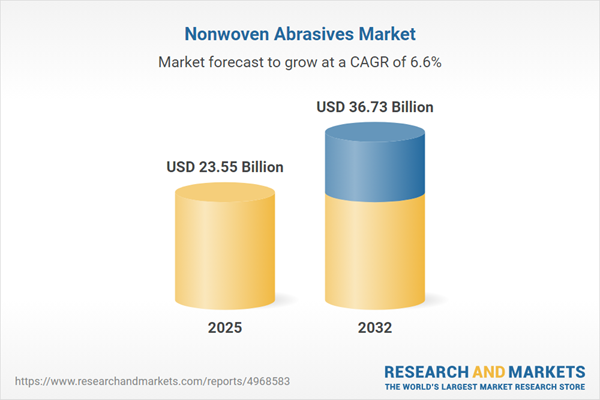Speak directly to the analyst to clarify any post sales queries you may have.
The nonwoven abrasives market is evolving rapidly, shaped by advanced material science and growing sustainability priorities. Senior executives are increasingly focused on how these engineered solutions deliver operational efficiency, reliable throughput, and compliance with global standards.
Market Snapshot: Nonwoven Abrasives Market Growth and Outlook
The global nonwoven abrasives market continues to gain momentum, reflecting increased adoption across automotive, aerospace, and metal fabrication industries. Recent years have seen robust investment in next-generation fiber and grain formulations. Consistent product innovation and evolving regulatory frameworks are advancing both the range and performance of nonwoven abrasive solutions.
Scope & Segmentation
This report covers in-depth analysis and segmentation, providing critical visibility for executive decision-making:
- Form: Belts, discs, sheets, and wheels for diverse surface preparation and finishing needs.
- End Use Industry: Targeted solutions for aerospace, automotive, metal fabrication, and woodworking sectors, supporting distinct application requirements.
- Application: Comprehensive review of deburring, polishing and finishing, and surface preparation functionalities.
- Abrasive Material: Evaluation of aluminum oxide, ceramic alumina, silicon carbide, and zirconia alumina compositions supporting varied performance demands.
- Backing Material: Analysis of nonwoven fiber, nylon, and polyester for resilience and dimensional stability.
- Bonding: Insights into adhesive and resin-based systems, highlighting the influence on removal rates and longevity.
- Distribution Channel: Direct sales, distributor partnerships, and online channels for optimized regional coverage and customer service.
- Regions: Americas; Europe, Middle East & Africa; Asia-Pacific—each reflecting unique industrial drivers, regulatory landscapes, and technology adoption curves.
- Companies: Profiles of industry leaders including 3M Company, Compagnie de Saint-Gobain S.A., Klingspor AG, TYROLIT Schleifmittelwerke Swarovski GmbH, E. Mansfeld & Söhne GmbH & Co. KG, Weiler Abrasives Group, LLC, INDASA S.A., Mirka Ltd., Hermes Schleifmittel GmbH, and SIA Abrasives (UK) Ltd.
Key Takeaways for Senior Decision-Makers
- The open-structure mesh of nonwoven abrasives provides uniform removal and reduces maintenance frequency, critical for high-speed and sensitive production lines.
- Advancements in fiber technology and grain selection enable solutions compatible with both delicate and heavy-duty substrates.
- Sustainability efforts in the sector focus on waste reduction, lower energy use, and support for circular economy initiatives, aligning with stricter corporate social responsibility mandates.
- Integration with digital manufacturing and sensor technologies is enabling real-time process adjustment, driving consistency, and safety improvements across industries.
- Regional dynamics are prompting manufacturers to broaden domestic capabilities and support localized supply chains, with notable shifts resulting from recent trade policy adjustments.
Tariff Impact and Strategic Response
Recent United States tariff revisions have had a measurable effect on the sourcing of essential fibers and abrasive grains. Increased duties challenge traditional procurement channels and have influenced both cost structures and supplier diversification strategies. Many organizations are expanding domestic manufacturing and logistics capabilities to counterbalance trade volatility and enhance supply chain resilience. These developments are leading to innovative cost-sharing models and collaborative supplier relationships, particularly with shifting global policy landscapes.
Methodology & Data Sources
The findings in this report stem from a rigorous research framework that combines primary interviews and surveys with in-depth secondary analysis of industry literature, patents, and regulatory sources. A triangulation approach ensures consistency and robust validation, with continuous peer review sessions to maintain data reliability.
Why This Report Matters
- Gain insight into material, technology, and regional factors driving market shifts and investment opportunities.
- Understand adaptive procurement and operational strategies to improve cost efficiency and risk mitigation.
- Inform sustainability, digitalization, and supply-chain decisions with actionable recommendations relevant for long-term sector leadership.
Conclusion
Nonwoven abrasives are shaping the evolution of industrial surface preparation, underpinned by material innovation and operational adaptability. This comprehensive analysis equips leaders with the clarity to optimize strategy in an increasingly dynamic competitive landscape.
Additional Product Information:
- Purchase of this report includes 1 year online access with quarterly updates.
- This report can be updated on request. Please contact our Customer Experience team using the Ask a Question widget on our website.
Table of Contents
3. Executive Summary
4. Market Overview
7. Cumulative Impact of Artificial Intelligence 2025
Companies Mentioned
The companies profiled in this Nonwoven Abrasives market report include:- 3M Company
- Compagnie de Saint-Gobain S.A.
- Klingspor AG
- TYROLIT Schleifmittelwerke Swarovski GmbH
- E. Mansfeld & Söhne GmbH & Co. KG
- Weiler Abrasives Group, LLC
- INDASA S.A.
- Mirka Ltd.
- Hermes Schleifmittel GmbH
- SIA Abrasives (UK) Ltd.
Table Information
| Report Attribute | Details |
|---|---|
| No. of Pages | 195 |
| Published | November 2025 |
| Forecast Period | 2025 - 2032 |
| Estimated Market Value ( USD | $ 23.55 Billion |
| Forecasted Market Value ( USD | $ 36.73 Billion |
| Compound Annual Growth Rate | 6.5% |
| Regions Covered | Global |
| No. of Companies Mentioned | 11 |








